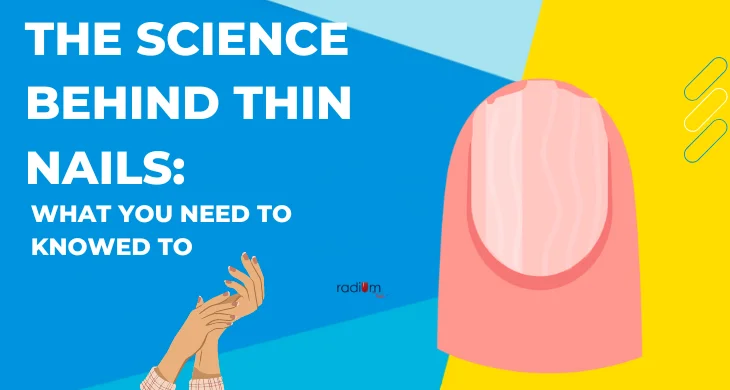Nails, those often-overlooked parts of our body, play a crucial role in protecting our fingertips and enhancing our sense of touch. They’re also a window into our overall health. When it comes to nails, thickness matters. Thin nails can be a sign of underlying issues, and understanding the science behind them is key to maintaining your overall well-being.
Anatomy of Nails:
“Anatomy of Nails” refers to the understanding of the structure and composition of human nails. It involves dissecting the various layers and components that make up nails, from the root to the tip. Key aspects of the anatomy of nails include:
- Nail Matrix: This is the base of the nail where new nail cells are generated. It’s a crucial part of nail growth and contributes to the strength and thickness of the nail.
- Nail Bed: The nail bed refers to the skin located underneath the nail plate.It plays a role in supporting the nail and providing nutrients for nail growth.
- Nail Plate: The visible part of the nail is called the nail plate. It’s composed of tightly packed layers of keratin, a protein that gives nails their hardness.
- Cuticle: The cuticle is a delicate skin layer that encases the nail’s base. It helps protect the nail matrix from infection and damage.
- Lunula: The lunula is the half-moon-shaped area at the base of the nail. It’s a visible part of the nail matrix and is often lighter in color.
Common Causes of Thin Nails:
Common Causes of Thin Nails : refers to the various factors and conditions that can lead to the thinning of human nails. Thin nails can be fragile, more prone to breaking, and less aesthetically pleasing. Some common causes of thin nails include:
- Nutritional Deficiencies: A lack of essential vitamins and minerals, especially biotin, iron, and calcium, can weaken nails and make them thinner.
- Excessive Moisture Exposure: Prolonged exposure to water and moisture, like frequent dishwashing without gloves, can soften and weaken nails, making them thin and more susceptible to damage.
- Harsh Chemicals: The use of strong chemicals, such as nail polish removers and acetone-based products, can strip the nails of their natural oils and proteins, leading to thinning.
- Medical Conditions: Underlying medical issues like thyroid disorders, anemia, and fungal infections can affect nail health, causing them to become thin and brittle.
- Aging: As people age, the rate of nail growth may slow down, and nails can naturally become thinner and more fragile.
- Medications: Certain medications, such as chemotherapy drugs, may have nail thinning as a side effect.
Signs of Thin Nails:
- Transparency: Thin nails are often transparent or semi-transparent, allowing you to see the nail bed underneath.
- Flexibility: Thin nails tend to be more flexible and can bend easily without breaking.
- Brittleness: While thin nails are flexible, they can also be brittle and prone to chipping or splitting.
- Ridging: Thin nails may have visible ridges or vertical lines running from the cuticle to the tip of the nail.
- Softness: Thin nails can feel soft and lack the firmness associated with thicker, healthier nails.
- Peeling: Thin nails may peel or flake at the edges, especially if they are exposed to moisture frequently.
- Slow Growth: In some cases, thin nails may grow more slowly than usual.
- White Spots: Some individuals with thin nails may notice white spots or discoloration on the nail surface.
Prevention and Long-Term Care for Thin Nails:
- Maintain a Balanced Diet: A diet rich in vitamins, minerals, and protein is essential for healthy nails. Include foods like lean proteins, fruits, vegetables, and whole grains in your diet.
- Hydration: Proper hydration is crucial for nail health.Ensure you stay well-hydrated by drinking a sufficient daily amount of water to keep your nails and cuticles moisturized.
- Nail Care Practices: Adopt gentle nail care practices. Avoid using harsh chemicals, excessive filing, or aggressive manicure techniques that can damage thin nails.
- Avoid Excessive Moisture: Prolonged exposure to water, such as frequent hand washing or soaking in water, can weaken nails. Use gloves when doing household chores or working with water.
- Protect Nails: Wear gloves while doing activities that could lead to nail damage, like gardening or cleaning.
- Use Nail Strengtheners: Consider using nail strengtheners or clear nail polish with added vitamins and minerals to protect and fortify your nails.
- Trim Regularly: Keep your nails trimmed to a manageable length to prevent snagging or breakage.
- Moisturize Cuticles: Apply cuticle oil or moisturizer regularly to keep the cuticles and nail bed hydrated.
The Science Behind Thin Nails:
Thin nails can be attributed to various factors, including the underlying science of nail growth and structure. Here’s a closer look at the science behind thin nails:
- Nail Structure: Nails are composed of multiple layers of a protein called keratin. These layers form the visible nail plate. The structure of these layers, as well as the arrangement of keratin, plays a crucial role in nail thickness.
- Keratin Protein: Keratin is the primary structural protein in nails, hair, and skin. The amount and quality of keratin in your nails influence their thickness and overall health.
- Growth Phases: Nails grow in phases, with the most active growth occurring at the nail matrix, the area beneath the cuticle. The matrix generates new cells that become part of the nail plate. Any disruptions or abnormalities in this growth process can lead to thin or brittle nails.
- Nutrition: The health of your nails is closely linked to your overall nutrition. A deficiency in essential vitamins and minerals, such as biotin, iron, and zinc, can result in weak and thin nails.
- Hydration: Nails require proper hydration to maintain their flexibility and strength. Dehydration can lead to dry, brittle, and thin nails.
- Medical Conditions: Certain medical conditions, such as thyroid disorders, fungal infections, and anemia, can affect nail thickness. Understanding these underlying health issues is essential for addressing thin nails.
- External Factors: External factors like excessive exposure to water, harsh chemicals, and trauma can damage the nail structure, making them thin and prone to breakage.
FAQS:
Q1: What causes nails to become thin?
A1: Thin nails can result from various factors, including nutritional deficiencies, dehydration, underlying medical conditions, and external factors like exposure to harsh chemicals or trauma.
Q2: Are thin nails a sign of a health problem?
A2: In some cases, yes. Thin nails can be associated with certain medical conditions like thyroid disorders or anemia. It’s advisable to consult a healthcare professional if you’re concerned about your nail health.
Q3: Can thin nails be hereditary?
A3: Yes, genetics can play a role in the natural thickness and strength of your nails. Some individuals may inherit genes that predispose them to thin or brittle nails.
Q4: How can I improve the thickness of my nails?
A4: To improve nail thickness, consider maintaining a balanced diet rich in essential vitamins and minerals, avoiding excessive exposure to water and harsh chemicals, staying hydrated, and addressing any underlying health issues.
Q5: Are there specific nail care products that can help with thin nails?
A5: Yes, certain nail strengtheners and moisturizers designed to nourish and protect nails can be beneficial. Look for products containing ingredients like biotin, keratin, and hydrating agents.
Conclusion:
Understanding the science behind thin nails is essential for maintaining healthy and strong nails. While thin nails can result from various factors, including genetics, nutrition, and external influences, taking proactive steps to care for your nails can make a significant difference. By embracing proper nail hygiene, a balanced diet, and protective measures, you can enhance the thickness and resilience of your nails. Remember that your nail health can also reflect your overall well-being, so paying attention to your nails is a valuable aspect of self-care.

